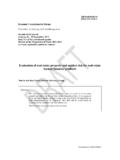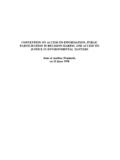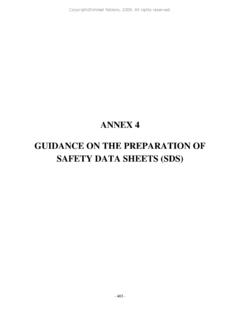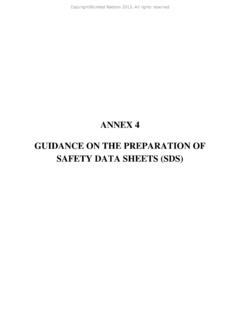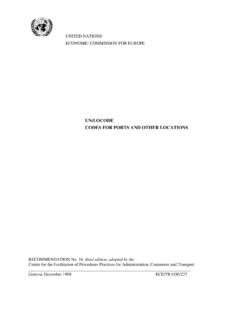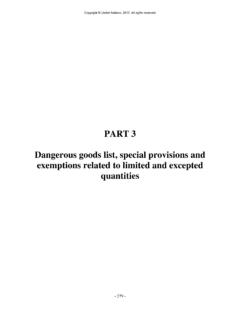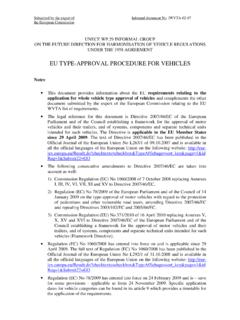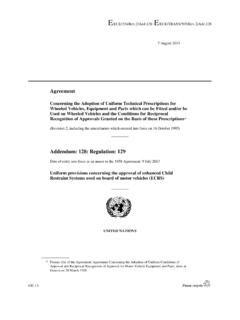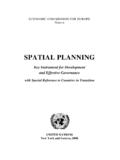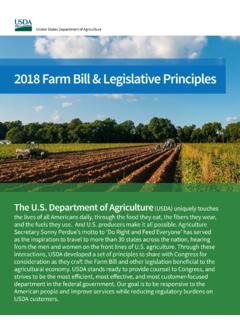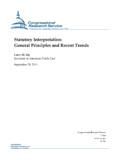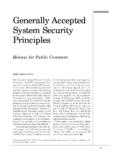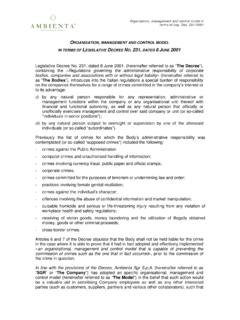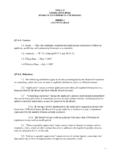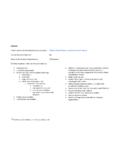Transcription of Principles and Guidelines on Confidentiality Aspects
1 Principles and Guidelines on Confidentiality Aspects of Data Integration Undertaken for Statistical or Related Research Purposes These Principles and Guidelines were endorsed by the Conference of European Statisticians at their June 2009 meeting. INTRODUCTION 1. At its eighth meeting, the United Nations Economic Commission for Europe (UNECE) adopted its decision C(47) on the fundamental Principles of official statistics in the region of the Economic Commission for Europe (15 April 1992 see ). Fundamental Principle number six states that Individual data collected by statistical agencies for statistical compilation, whether they refer to natural or legal persons, are to be strictly confidential and used exclusively for statistical purposes. 2. Data integration is concerned with integrating unit record data from different administrative and/or survey sources to compile new official statistics which can then be released in their own right.
2 In addition, these integrated data sets may be used to support a range of economic and social research not possible using traditional sources. In some cases the use of integrated data sets can introduce additional legal and policy concerns compared to the use of single-source data sets. These additional concerns typically relate to, but are not necessarily limited to privacy and data protection requirements. These Principles and Guidelines , whilst having some relevance to the creation and maintenance of statistical registers, do not cover these tasks. 3. These Principles and Guidelines apply to data integration work carried out in national statistical organizations (NSOs). In some cases international statistical organisations combine micro-data sets from different countries, but as there are unlikely to be any units in common between the national data files, no Confidentiality issues arise here.
3 4. For the purpose of these Principles and Guidelines , the use of other sources in validation and imputation processes for a single source, is not considered as data integration, though similar issues may apply. Two instances of the same survey are considered to be a single source. 5. To assist in the use of these Principles and Guidelines the following definitions are used: (a) Composite microdata - unit record data resulting from data integration; (b) Confidentiality - an obligation to the provider of information to maintain the secrecy of that information; (c) Data Integration - the process of combining data from two or more sources to produce new outputs; (d) Data Matching - the linkage of micro-data from different sources based on common features present in those sources; (e) Data Provider - An organization which produces data or metadata. For the purposes of these Principles and Guidelines , this term includes providers of data files from statistical or non-statistical sources, but not individual respondents to statistical surveys; (f) Natural or legal persons - individuals and legal entities recognised by national legislation; (g) Official Statistics - any statistical activity carried out within a national statistical system, or under the statistical programme of an intergovernmental organization; (h) Privacy - someone's right to keep their personal matters and relationships secret, involving an obligation of the holder of information to the subject of the information to do so.
4 (i) Research Purposes - in the context of these Principles and Guidelines , related research purposes are defined as ad-hoc activities to investigate or explain economic or social phenomena, which result in statistical outputs. These activities may be undertaken by a statistical organization (in which case the results may not necessarily be published), or by external researchers (following the Conference of European Statisticians Principles and Guidelines on managing statistical Confidentiality and microdata access ). (j) Statistical Activity - the collection, storage, transformation and distribution of statistical information; (k) Statistical Purposes - the use of data in a way that complies with the Fundamental Principles of Official Statistics, fits into one or more phases of the statistical business process, and contributes to the production of official statistics.
5 6. Integration of data may include exact matching, probabilistic matching and/or statistical matching. The benefits of integrated data sets can include: (a) Production of new or enhanced statistics; (b) Production of more disaggregated information for measures where some information currently exists; (c) Ability to carry out research using composite microdata that cover a wider range of variables for a larger number of units than available from any single data source; (d) Potential to improve or validate existing data sources; (e) Potential to reduce respondent burden. 7. The attached Principles and associated Guidelines expand on Fundamental Principle six by providing a common framework for assessing and mitigating legislative and other Confidentiality Aspects of the creation and use of integrated datasets for statistical and research purposes.
6 In particular they recognise that the fundamental Principles of official statistics apply equally to integrated data sets as to any other source of official statistics. 8. In developing these Principles , it is recognised that it is government policy in some countries to first seek to use (integrated) administrative data sources, such as registers, for the production of official statistics, only conducting surveys if crucial variables are missing or are of too low a quality in the available administrative sources. In these countries, integration of statistical data sets is a normal part of the operations of the national statistical office. These countries usually already have a strong framework of legislation and clear rules about protection of the Confidentiality of personal and individual business data, irrespective of whether or not the data has been integrated from different sources.
7 9. However, for many other countries the notion of integrating data to produce composite microdata from different sources for statistical and related research purposes is relatively new. The attached Principles , associated Guidelines , and the example of a business case outline, are designed to provide a framework for such work that can provide some clarity and consistency of application. 10. In addition to the Principles and Guidelines below, two other notions have been identified that may be relevant in certain circumstances, particularly for countries that do not have a strong tradition of data integration activities for official statistics purposes. The first is that data integration must not occur when it will materially threaten the integrity of the source data collections, for example by posing a risk of reduced response rates.
8 The second is that data integration for research purposes should only be considered where the approval process can justify that this is in the public interest. It is assumed that official statistical purposes will always serve the public interest if they comply with the fundamental Principles of official statistics. These notions are mentioned here for completeness, but are not as widely accepted, and therefore do not have the same status as the Principles below. Principles AND Guidelines Principle 1 Data integration should be undertaken by NSOs (and other organizations within national statistical systems) only for statistical and related research purposes. Guidelines : (a) The above principle should be enshrined in either the statistics legislation and/or in the legislation on data protection, and be strictly respected by governments; (b) In circumstances where no explicit legislative protection exists, NSOs should abstain from data integration concerning natural and legal persons; (c) Unless national legislation stipulates otherwise, the use for statistical or research purposes by NSOs of any existing data held in national or sub-national government departments or public authorities, from administrative or statistical sources, does not contravene the privacy of a specific natural or legal person.
9 Principle 2 NSOs should only undertake data integration activities consistent with their official statistics mandate and after completing a standard approval process (for example, a business case). Guidelines : (a) Where a NSO has a mandate(s) that goes beyond statistical and related research purposes, such as involving the use of data for administrative or regulatory purposes related to natural persons, it should abstain from any data integration activities for statistical or related research purposes pertaining to these units, unless this is specifically authorized by law; (b) Before undertaking a new survey for statistical purposes, consideration should be given as to whether integration of data sources already available at the NSO could be used as an alternative means; (c) A standard approval process should be followed for any new data integration proposal.
10 This may take the form of a formal business case. An example of a business case outline is given in the Annex, but each country should establish their own template for the process of endorsing data integration projects. The approval process should identify how the integration work will produce or improve official statistics or contribute to related research. Principle 3 The public benefits of any data integration project should be sufficient to outweigh any privacy or Confidentiality concerns about the use of data and/or risks to the integrity of the official statistics system. Guidelines : (a) Data integration should occur in a secure environment and in a manner that does not pose risks to the integrity of the official statistical system; (b) Unless enabled by legislation or provided for in the standard approval process, any direct identifiers associated with the data to be integrated should be removed as soon as possible upon completion of the integration process; (c) Where appropriate, bodies with responsibility for ensuring that all benefits, privacy concerns and risks are identified and properly considered by the NSO as part of their standard approval process, should be consulted.
